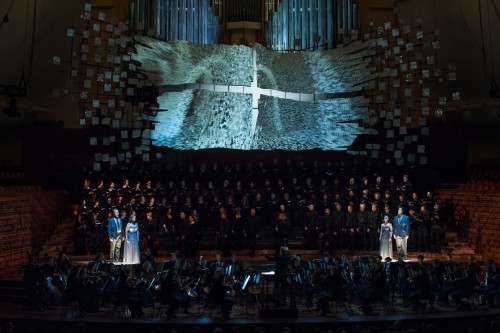 United StatesBeethoven, Missa Solemnis: Joélle Harvey (soprano), Sasha Cooke (mezzo-soprano), Brandon Jovanovich (tenor), Shenyang (bass-baritone), Pacific Boychoir (Kevin Fox, director), San Francisco Symphony Chorus (Ragnar Bohlin, director), San Francisco Symphony, Michael Tilson Thomas (conductor). 10.6.2015 (HS)
United StatesBeethoven, Missa Solemnis: Joélle Harvey (soprano), Sasha Cooke (mezzo-soprano), Brandon Jovanovich (tenor), Shenyang (bass-baritone), Pacific Boychoir (Kevin Fox, director), San Francisco Symphony Chorus (Ragnar Bohlin, director), San Francisco Symphony, Michael Tilson Thomas (conductor). 10.6.2015 (HS)
Beethoven: Missa Solemnis, Opus 123
Production conceived by Michael Tilson Thomas
Stage director: James Darrah
Lighting design: David Finn
Video designer: Finn Ross
Scenic design: Cameron Mock, Emily Anne MacDonald
Why add staging to Beethoven’s Missa Solemnis, the composer’s monumental setting of the Latin Mass for orchestra and chorus? In his program note, San Francisco Symphony music director Michael Tilson Thomas explains that he wanted to “create more space around the music” in a work that can “seem impenetrable.” With its complexity, dense layers of counterpoint, and a mass of choruses and soloists, the many strands of Missa Solemnis can, as Tilson Thomas writes, be difficult to follow. “It’s like Messiah on steroids,” he writes.

(Photo: Stefan Cohen)
For me the staging, first seen earlier this year with the Los Angeles Philharmonic at Disney Hall, did make visual what was happening in the music. Sometimes that was for the good, but at others it distracted from what was a revelatory musical experience.
This conductor’s approach to Beethoven aimed for transparent musical textures, urgent rhythms and gorgeous purity of sound. The soloists, required to memorize their music and move about the stage, brought a sense of freedom and power, plus a real presence that infused everything with more life. Soprano Joélle Harvey was especially radiant, and tenor Brandon Jovanovich deployed his Wagner-ready tenor with remarkable fluidity, grace and precision. (Both had sung in the Los Angeles production.) New to the proceedings were mezzo-soprano Sasha Cooke, with her butterscotch pudding richness of sound and clarity of text, and bass-baritone Shenyang, whose rendering of the bass solo in final “Agnus Dei” was especially moving.
This conductor envisages the opening “Kyrie” as a burst of light that reveals the interior of a cathedral, and that’s what was projected onto a stylized screen suggesting torn paper, exploding at the edges, a ragged cross cut into the center. Tilson Thomas experiences the joyful “Gloria” as a wave of words. Using alphabet letters projected on the screen throughout the 80 minutes of the score, the letters shaped themselves from inchoate clouds into the outlines of a cathedral or an impression of stars and galaxies.
Below these projections, members of the chorus and the four soloists moved across a stage-like platform above and behind the orchestra. Clad in black and playing often in the dark from lighted music stands, the instrumentalists seemed more anonymous, except when concertmaster Alexander Barantschik appeared on the platform to play the exquisite violin solo in the Benedictus, the vocal soloists gathered around him in awe.
In another nice musical touch, Tilson Thomas assigned the solo parts (written in the forms of Renaissance music) to a quartet composed of chorus members (alas uncredited) the better to differentiate this music from Beethoven’s richer Romantic style.
According to his program note, Tilson Thomas wanted us to experience a spiritual journey, entering a cathedral, being touched by the words and music, and returning to earthly life at the quiet, almost anti-climactic ending.
Given that some audience members may not have read the program, it’s hard to say how much of all of that they have actually got. To some, it might have seemed like too many people wandering about the stage. At a restaurant after the concert, a man with a resonant bass voice sitting at the next table was overheard to say, “meh” when his companion asked about the staging. But it’s hard to say how much reading the program note added to my wife’s experience of the “Credo.” She was in tears. It might just have been the music’s finely poised and gradual expansion of sound and rhythmic momentum. It starts from a whisper and piles on the “I believes,” fusing the instruments of the orchestra with the human voice into a towering monument.
That’s what a performance of this music should achieve. It’s more than a setting of the mass as it might be heard in a church. Beethoven uses his techniques and his revolutionary ideas to plumb depths of liturgical music as thoroughly as he does in his late string quartets and communicate a populous mind-set as intensely as his ninth symphony.
The music in this performance certainly got us there. And if the staging helped, so much the better.
Harvey Steiman
